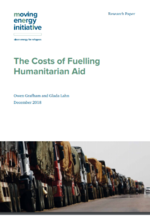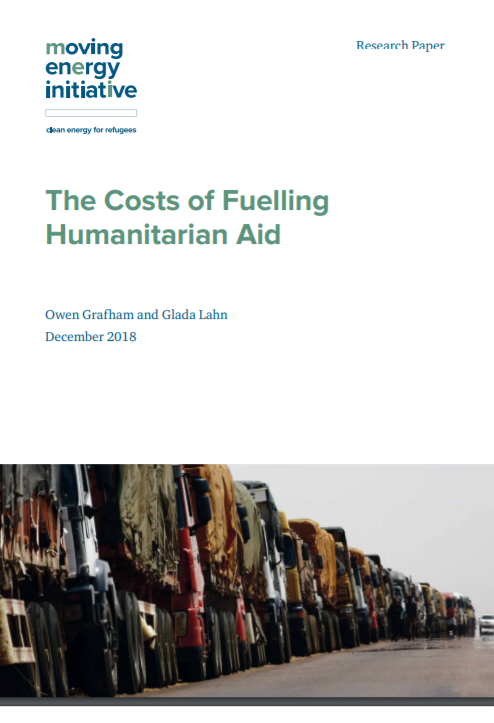Difference between revisions of "The Costs of Fuelling Humanitarian Aid"
***** (***** | *****) |
***** (***** | *****) |
||
| Line 111: | Line 111: | ||
<br/> | <br/> | ||
| + | |||
| Line 116: | Line 117: | ||
= Further Information = | = Further Information = | ||
| − | *[ | + | *[[File:Fuelling_Humanitarian_Aid.PNG|The Costs of Fuelling Humanitarian Aid Full Report]] |
*[https://mei.chathamhouse.org/costs-fuelling-humanitarian-aid The Costs of Fuelling Humanitarian Aid Summary] | *[https://mei.chathamhouse.org/costs-fuelling-humanitarian-aid The Costs of Fuelling Humanitarian Aid Summary] | ||
*[[Powering Ahead - Improving How We Use and Account for Energy in Humanitarian Operations - Toolkit|Powering Ahead - Improving How We Use and Account for Energy in Humanitarian Operations - Toolkit]] | *[[Powering Ahead - Improving How We Use and Account for Energy in Humanitarian Operations - Toolkit|Powering Ahead - Improving How We Use and Account for Energy in Humanitarian Operations - Toolkit]] | ||
| Line 122: | Line 123: | ||
*[[The Moving Energy Initiative|The Moving Energy Initiative]] | *[[The Moving Energy Initiative|The Moving Energy Initiative]] | ||
*[[A Global Plan of Action - Background, Visions and Outcomes|Global Plan of Action]] | *[[A Global Plan of Action - Background, Visions and Outcomes|Global Plan of Action]] | ||
| − | *More articles and documents on energy in [[:Category: | + | *More articles and documents on energy in [[:Category:Humanitarian Settings|humanitarian settings]], available on energypedia |
| + | [[Category:Humanitarian_Settings]] | ||
| + | [[Category:Financing_and_Funding]] | ||
| + | [[Category:Kenya]] | ||
| + | [[Category:Jordan]] | ||
[[Category:Burkina_Faso]] | [[Category:Burkina_Faso]] | ||
| − | |||
| − | |||
| − | |||
| − | |||
Revision as of 15:42, 16 January 2019
The Costs of Fuelling Humanitarian Aid - Introduction
As humanitarian crises become more protracted and aid budgets face unprecedented scrutiny, agencies could save millions by switching from diesel and oil fuels to cleaner energy sources.
Most refugee and internal displacement camps are in remote locations, so humanitarian agencies consume large amounts of fuel on the transport of staff, equipment and goods such as food and water. Operations tend to rely on on-site electricity generation to power reception centres, clinics, schools, food storage, water-pumping and street lighting.
Despite the essential role of energy in humanitarian action, and the UN´s stated commitment to carbon neutrality by 2020, to date there is no concerted effort to move away from fossil fuels. The Costs of Fuelling Humanitarian Aid, a new report by Chatham House for the Moving Energy Initiative (MEI), offers the first ever assessment of energy use by humanitarian organizations.
Key Findings
The report is based on a survey of 21 organizations operating in the humanitarian sector in Burkina Faso, Kenya and Jordan, complemented by interviews with key staff involved in setting energy policy. The following problems have been found:
- Involved agencies are heavily dependent on oil fuel for electricity generation, for which they are paying too much, even though renewable energy technologies are capable of reducing costs, being deployed in similar conditions.
- The way in which fuel is distributed in camps, between agencies who are in contract with UN Refugee Agency (UNHCR), does not usually motivate these agencies to conserve fuel. Hence, these agencies have very few -if any- incentives to perform better.
- What for and how much is spent on energy by these different agencies lack transparency, as few agencies collect and report on energy use.
- Due to the absence of concrete reliable data from the majority of humanitarian agencies with regard to energy costs or potential savings, then any estimates would probably be highly flawed. Nonetheless, this research approximately estimates that around 5% of humanitarian agencies expenditure is on diesel, petrol, and associated costs, indicating that around $1.2 billion have been spent on polluting fuel in 2017.
- The paper examines few practices - currently available, affordable and proven in practice -, which are considered the best in terms of helping the individual agencies to create a large saving margins. Based on current best practices, the humanitarian aiding sector could save at least 10% of fuel costs on ground transport, 37% through behaviour change and more efficient technologies, and 60% on generation; this could lead to an operational saving of $517 million/year for the humanitarian sector (~5% of UNHCR's funding gap for 2017).
- In addition to the financial gains, adopting energy strategies, which promote sustainable energy in countries of operation, would also help humanitarian agencies building positive relations with the host-country governments and societies.
Country Key Findings
| Country | Key Findings |
|---|---|
| Kenya |
|
| Jordan |
|
| Burkina Faso |
|
- Fleet sharing and fuel-management practices would make sense in the three countries as that would:
- Increase transport-fuel savings.
- Improve air quality.
- Another negative outcome -due to the lack of precise data on energy use, costs and alternatives- is frequently missing opportunities to do things differently by the decision makers.
Recommendations
Recommendations for Humanitarian Agencies
As part of their commitment to ‘do no harm’, humanitarian agencies should commit to reducing their emissions footprint in host countries and set targets for phasing out the use of diesel for electricity generation.
Furthermore, they should tell donors how important the transition to sustainable energy and efficiency is for agencies.
Begin rationalizing energy use by following a ‘3M’ strategy:
- Measuring – Collecting energy and emissions data
- Monitoring – Reporting on these data and identifying ‘low-hanging fruit’ where improvements would pay back an initial investment in a short period
- Motivating – Introducing emissions reduction targets as key performance indicators and encouraging entrepreneurial activities by country teams such as partnerships with firms providing renewable energy services and cooperation with other agencies
In particular, strategy should include the following measures:
- Identify where agencies are spending the most money across offices on logistics and operations.
- Set targets for phasing out diesel for electricity generation across operations
- Set a target and timeline for improving the efficiency of agency vehicle fleets, and for investigating how journeys can be reduced. Sharing procedures trialled by some agencies should be implemented at scale.
- Investigate the potential for switching to cleaner fuels.
- Consider setting incentive and disincentive schemes at headquarters that encourage good practice across the agencies
- Make energy a priority at headquarters and work with field office staff to integrate a culture of efficiency.
Recommendations for Donors
- Demanding humanitarian agencies to provide a breakdown of energy cost projections in budgets, and backing them up with assumptions about consumption and costs.
- Investigating what is actually being done by which agencies to reduce fuel costs and emissions in the country of operation.
- Offer support to projects that unlock system change, and that enable models that can be adapted for replication.
- Consider contributing to a multi-country fund to de-risk the larger investments to transform large displacement operation.
Recommendations for Local Governments & Host Countries
- Ask humanitarian agencies what steps they are taking to reduce their emissions and impact on host-country resources.
- Where possible, include sustainable energy as a priority area in humanitarian response plans (HRPs) and encourage aid in energy projects that will leave a positive legacy in-country.
- In cases of prolonged displacement/humanitarian presence, consider enabling infrastructure investments that will reduce energy and water demand in camps and harness local market expertise.
- Consider partnerships with humanitarian agencies operating in remote locations to improve energy access for rural areas.
Further Information
- The Costs of Fuelling Humanitarian Aid Summary
- Powering Ahead - Improving How We Use and Account for Energy in Humanitarian Operations - Toolkit
- Switch to clean energy and save $500 mln, aid agencies told. Reuters, Dec 10, 2018
- The Moving Energy Initiative
- Global Plan of Action
- More articles and documents on energy in humanitarian settings, available on energypedia





















